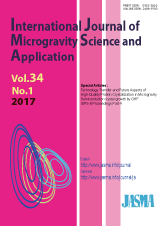34 巻, 1 号
宇宙における高品質タンパク質結晶化技術の伝承と可能性
選択された号の論文の17件中1~17を表示しています
- |<
- <
- 1
- >
- >|
-
2017 年 34 巻 1 号 p. 340101-
発行日: 2017/01/31
公開日: 2020/05/14
PDF形式でダウンロード (345K) -
2017 年 34 巻 1 号 p. 340102-
発行日: 2017/01/31
公開日: 2020/05/14
PDF形式でダウンロード (887K) -
2017 年 34 巻 1 号 p. 340103-
発行日: 2017/01/31
公開日: 2020/05/14
PDF形式でダウンロード (844K) -
2017 年 34 巻 1 号 p. 340104-
発行日: 2017/01/31
公開日: 2020/05/14
PDF形式でダウンロード (643K) -
2017 年 34 巻 1 号 p. 340105-
発行日: 2017/01/31
公開日: 2020/05/14
PDF形式でダウンロード (1127K) -
2017 年 34 巻 1 号 p. 340106-
発行日: 2017/01/31
公開日: 2020/05/14
PDF形式でダウンロード (1016K) -
2017 年 34 巻 1 号 p. 340107-
発行日: 2017/01/31
公開日: 2020/05/14
PDF形式でダウンロード (798K) -
2017 年 34 巻 1 号 p. 340108-
発行日: 2017/01/31
公開日: 2020/05/14
PDF形式でダウンロード (874K) -
2017 年 34 巻 1 号 p. 340109-
発行日: 2017/01/31
公開日: 2020/05/14
PDF形式でダウンロード (698K) -
2017 年 34 巻 1 号 p. 340110-
発行日: 2017/01/31
公開日: 2020/05/14
PDF形式でダウンロード (868K) -
2017 年 34 巻 1 号 p. 340111-
発行日: 2017/01/31
公開日: 2020/05/14
PDF形式でダウンロード (1718K) -
2017 年 34 巻 1 号 p. 340112-
発行日: 2017/01/31
公開日: 2020/05/14
PDF形式でダウンロード (745K) -
2017 年 34 巻 1 号 p. 340113-
発行日: 2017/01/31
公開日: 2020/05/14
PDF形式でダウンロード (1088K) -
2017 年 34 巻 1 号 p. 340114-
発行日: 2017/01/31
公開日: 2020/05/14
PDF形式でダウンロード (722K) -
2017 年 34 巻 1 号 p. 340115-
発行日: 2017/01/31
公開日: 2020/05/14
PDF形式でダウンロード (1127K) -
2017 年 34 巻 1 号 p. 340116-
発行日: 2017/07/31
公開日: 2020/05/14
PDF形式でダウンロード (909K) -
2017 年 34 巻 1 号 p. 340117-
発行日: 2017/07/31
公開日: 2020/05/14
PDF形式でダウンロード (1060K)
- |<
- <
- 1
- >
- >|
